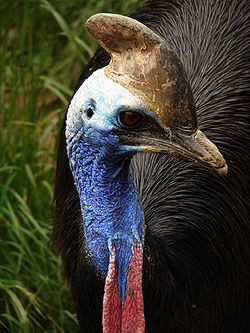
Back شبنميات Arabic شبنميات ARZ Narkoydunol (Casuariiformes) AVK Kazuarkimilər Azerbaijani Казуароподобни Bulgarian Casuariformes Catalan Casuariiformes CEB Kasuáři Czech Casuariiformes Welsh Kasuarfugle Danish
| Casuariiformes Temporal range: Possible Paleocene appearance.
| |
|---|---|

| |
| Southern cassowary | |
| Scientific classification | |
| Domain: | Eukaryota |
| Kingdom: | Animalia |
| Phylum: | Chordata |
| Class: | Aves |
| Infraclass: | Palaeognathae |
| Clade: | Novaeratitae |
| Order: | Casuariiformes (Sclater, 1880) Forbes, 1884[1] |
| Families | |
| |
| Diversity | |
| 1 or 2 families, 4 genera (including 2 extinct), 9 species (including 5 extinct) | |
| Synonyms[2] | |
| |
The Casuariiformes /kæsjuːˈæri.ɪfɔːrmiːz/ is an order of large flightless birds that has four surviving members: the three species of cassowary, and the only remaining species of emu. They are divided into either a single family, Casuariidae, or occasionally two, with the emu splitting off into its own family, Dromaiidae. The IOC World Bird List and Cornell Lab of Ornithology's Birds of the World both do not recognize Dromaiidae, placing the emu in the family Casuariidae.[3][4]
All four living members are native to Australia-New Guinea,[5] but some possible extinct taxa occurred in other landmasses.
- ^ Brand, S. (2008)
- ^ Brodkob, Pierce (1963). "Catalogue of fossil birds 1- Archaeopterygiformes through Ardeiformes". Biological Sciences, Bulletin of the Florida State Museum. 7 (4): 180–293. Retrieved 30 December 2015.
- ^ "Ratites: Ostriches to tinamous". IOC World Bird List v15.1. Retrieved 14 March 2025.
- ^ "Emu (Dromaius novaehollandiae)". Birds of the World. Cornell Lab of Ornithology. 4 March 2020. Retrieved 14 March 2025.
- ^ Clements, J (2007)
© MMXXIII Rich X Search. We shall prevail. All rights reserved. Rich X Search